Deck 11: Ethers, Epoxides, and Sulfides
Question
Question
Question
Question
Question
Question
Question
Question
Question
Question
Question
Question
Question
Question
Question
Question
Question
Question
Question
Question
Question
Question
Question
Question
Question
Question
Question
Question
Question
Question
Question
Question
Question
Question
Question
Question
Question
Question
Question
Question
Question
Question
Question
Question
Question
Question
Question
Question
Question
Question
Question
Question
Question
Question
Question
Question
Question
Question
Question
Question
Question
Question
Question
Question
Question
Question
Question
Question
Question
Question
Question

Unlock Deck
Sign up to unlock the cards in this deck!
Unlock Deck
Unlock Deck
1/71
Play
Full screen (f)
Deck 11: Ethers, Epoxides, and Sulfides
1
What is the major organic product obtained from the following reaction? 
A) 1
B) 2
C) 3
D) 4

A) 1
B) 2
C) 3
D) 4
2
2
What is the major organic product obtained from the following reaction? 
A) 1
B) 2
C) 3
D) 4

A) 1
B) 2
C) 3
D) 4
3
3
What is the IUPAC name of the following compound? 
A) ethyl isopropyl thiol
B) 2-ethylsulfanylpropane
C) ethyl isopropyl disulfide
D) isopropylsufanylethane

A) ethyl isopropyl thiol
B) 2-ethylsulfanylpropane
C) ethyl isopropyl disulfide
D) isopropylsufanylethane
2-ethylsulfanylpropane
4
Which of the following are epoxides? 
A) only 2 and 3
B) only 3 and 4
C) only 2, 3 and 4
D) 1, 2, 3 and 4

A) only 2 and 3
B) only 3 and 4
C) only 2, 3 and 4
D) 1, 2, 3 and 4

Unlock Deck
Unlock for access to all 71 flashcards in this deck.
Unlock Deck
k this deck
5
What type of mechanism accounts for the cleavage of tert-butyl methyl ether upon treatment with HBr?
A) SN1
B) SN2
C) E1
D) E2
A) SN1
B) SN2
C) E1
D) E2

Unlock Deck
Unlock for access to all 71 flashcards in this deck.
Unlock Deck
k this deck
6
What is the major organic product obtained from the following reaction? 
A) 1
B) 2
C) 3
D) 4

A) 1
B) 2
C) 3
D) 4

Unlock Deck
Unlock for access to all 71 flashcards in this deck.
Unlock Deck
k this deck
7
What type of mechanism accounts for the cleavage of dibutyl ether upon treatment with HBr to give two moles of 1-bromobutane?
A) SN1
B) SN2
C) E1
D) E2
A) SN1
B) SN2
C) E1
D) E2

Unlock Deck
Unlock for access to all 71 flashcards in this deck.
Unlock Deck
k this deck
8
What is the IUPAC name of the following compound? 
A) cis-1,4-anisole
B) cis-4-methoxyanisole
C) cis-1,4-dimethoxycyclohexane
D) para-dianisole

A) cis-1,4-anisole
B) cis-4-methoxyanisole
C) cis-1,4-dimethoxycyclohexane
D) para-dianisole

Unlock Deck
Unlock for access to all 71 flashcards in this deck.
Unlock Deck
k this deck
9
Which of the following are ethers? 
A) only 1 and 2
B) only 1 and 4
C) only 1, 2 and 3
D) 1, 2, 3 and 4

A) only 1 and 2
B) only 1 and 4
C) only 1, 2 and 3
D) 1, 2, 3 and 4

Unlock Deck
Unlock for access to all 71 flashcards in this deck.
Unlock Deck
k this deck
10
Which of the following statements are true?
1.ethanol is more soluble in water than dimethyl ether
2.ethanol has a higher boiling point than dimethyl ether
3.ethanol has the same molecular weight as dimethyl ether
A) only 1
B) only 1 and 2
C) only 1 and 3
D) 1, 2 and 3
1.ethanol is more soluble in water than dimethyl ether
2.ethanol has a higher boiling point than dimethyl ether
3.ethanol has the same molecular weight as dimethyl ether
A) only 1
B) only 1 and 2
C) only 1 and 3
D) 1, 2 and 3

Unlock Deck
Unlock for access to all 71 flashcards in this deck.
Unlock Deck
k this deck
11
What is the correct assignment of the names of the following ethers? 
A) 1 = oxirane; 2 = oxetane; 3= oxolane
B) 1 = oxetane; 2 = oxirane; 3= oxane
C) 1 = oxane; 2 = oxetane; 3= dioxane
D) 1 = oxirane; 2 = oxolane; 3= oxetane

A) 1 = oxirane; 2 = oxetane; 3= oxolane
B) 1 = oxetane; 2 = oxirane; 3= oxane
C) 1 = oxane; 2 = oxetane; 3= dioxane
D) 1 = oxirane; 2 = oxolane; 3= oxetane

Unlock Deck
Unlock for access to all 71 flashcards in this deck.
Unlock Deck
k this deck
12
What is the major organic product obtained from the following reaction? 
A) 1
B) 2
C) 3
D) 4

A) 1
B) 2
C) 3
D) 4

Unlock Deck
Unlock for access to all 71 flashcards in this deck.
Unlock Deck
k this deck
13
What type of reactive intermediate is formed in the reaction of tert-butyl methyl ether with HBr to give tert-butyl bromide?
A) tert-butyl anion
B) tert-butoxide
C) tert-butyl radical
D) tert-butyl cation
A) tert-butyl anion
B) tert-butoxide
C) tert-butyl radical
D) tert-butyl cation

Unlock Deck
Unlock for access to all 71 flashcards in this deck.
Unlock Deck
k this deck
14
Which of the following ethers cannot be prepared by a Williamson ether synthesis?
A) tert-butyl phenyl ether
B) isopropyl methyl ether
C) anisole
D) tert-butyl methyl ether
A) tert-butyl phenyl ether
B) isopropyl methyl ether
C) anisole
D) tert-butyl methyl ether

Unlock Deck
Unlock for access to all 71 flashcards in this deck.
Unlock Deck
k this deck
15
What is the correct assignment of the names of the following ethers? 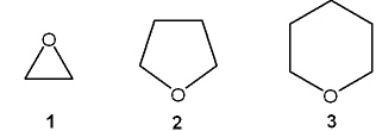
A) 1 = oxirane; 2 = oxetane; 3 = oxane
B) 1 = oxirane; 2 = oxitane; 3 = oxane
C) 1 = oxane; 2 = dioxane; 3 = oxetane
D) 1 = oxirane; 2 = oxolane; 3 = oxane

A) 1 = oxirane; 2 = oxetane; 3 = oxane
B) 1 = oxirane; 2 = oxitane; 3 = oxane
C) 1 = oxane; 2 = dioxane; 3 = oxetane
D) 1 = oxirane; 2 = oxolane; 3 = oxane

Unlock Deck
Unlock for access to all 71 flashcards in this deck.
Unlock Deck
k this deck
16
Which of the following reactions provides tert-butyl methyl ether in a high yield?
A) potassium tert-butoxide + iodomethane
B) sodium methoxide + tert-butyl bromide
C) methanol + tert-butyl alcohol in the presence of KOH
D) iodomethane + tert-butyl bromide in the presence of KOH
A) potassium tert-butoxide + iodomethane
B) sodium methoxide + tert-butyl bromide
C) methanol + tert-butyl alcohol in the presence of KOH
D) iodomethane + tert-butyl bromide in the presence of KOH

Unlock Deck
Unlock for access to all 71 flashcards in this deck.
Unlock Deck
k this deck
17
What is the major organic product obtained from the following reaction? 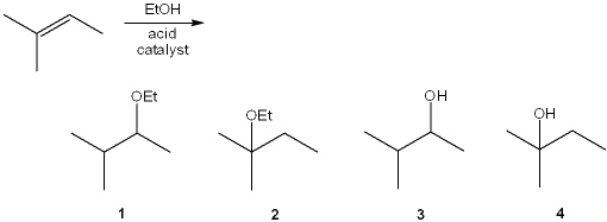
A) 1
B) 2
C) 3
D) 4

A) 1
B) 2
C) 3
D) 4

Unlock Deck
Unlock for access to all 71 flashcards in this deck.
Unlock Deck
k this deck
18
What is the major organic product obtained from the following reaction? 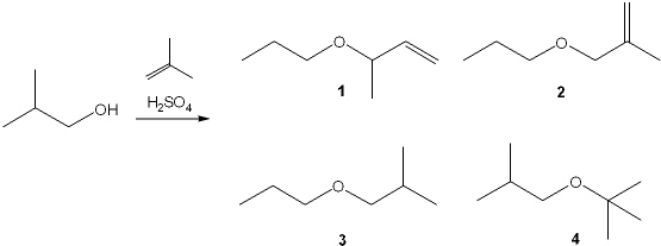
A) 1
B) 2
C) 3
D) 4

A) 1
B) 2
C) 3
D) 4

Unlock Deck
Unlock for access to all 71 flashcards in this deck.
Unlock Deck
k this deck
19
Which of the following reactions provides anisole (PhOCH3) in a high yield?
A) phenol + sodium methoxide
B) bromobenzene + bromomethane
C) sodium phenoxide (PhONa) + bromomethane
D) bromobenzene + sodium methoxide
A) phenol + sodium methoxide
B) bromobenzene + bromomethane
C) sodium phenoxide (PhONa) + bromomethane
D) bromobenzene + sodium methoxide

Unlock Deck
Unlock for access to all 71 flashcards in this deck.
Unlock Deck
k this deck
20
Which of the following are thiols? 
A) only 1
B) only 1 and 4
C) only 2 and 3
D) 1, 2, 3 and 4

A) only 1
B) only 1 and 4
C) only 2 and 3
D) 1, 2, 3 and 4

Unlock Deck
Unlock for access to all 71 flashcards in this deck.
Unlock Deck
k this deck
21
What is the major organic product obtained from the following sequence of reactions? 
A) 1
B) 2
C) 3
D) 4

A) 1
B) 2
C) 3
D) 4

Unlock Deck
Unlock for access to all 71 flashcards in this deck.
Unlock Deck
k this deck
22
What is the major organic product obtained from the following sequence of reactions? 
A) 1
B) 2
C) 3
D) 4

A) 1
B) 2
C) 3
D) 4

Unlock Deck
Unlock for access to all 71 flashcards in this deck.
Unlock Deck
k this deck
23
What is the major organic product obtained from the following reaction? 
A) 1
B) 2
C) 3
D) 4

A) 1
B) 2
C) 3
D) 4

Unlock Deck
Unlock for access to all 71 flashcards in this deck.
Unlock Deck
k this deck
24
What are the major products obtained upon treatment of tert-butyl methyl ether with excess HBr?
A) tert-butyl alcohol and methanol
B) tert-butyl bromide and methanol
C) tert-butyl alcohol and bromomethane
D) tert-butyl bromide and bromomethane
A) tert-butyl alcohol and methanol
B) tert-butyl bromide and methanol
C) tert-butyl alcohol and bromomethane
D) tert-butyl bromide and bromomethane

Unlock Deck
Unlock for access to all 71 flashcards in this deck.
Unlock Deck
k this deck
25
What is the major organic product obtained from the following reaction? 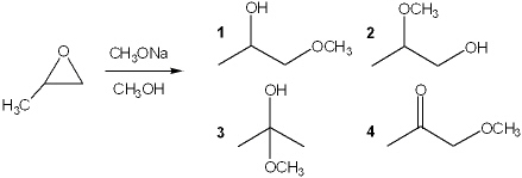
A) 1
B) 2
C) 3
D) 4

A) 1
B) 2
C) 3
D) 4

Unlock Deck
Unlock for access to all 71 flashcards in this deck.
Unlock Deck
k this deck
26
What are the major products obtained upon treatment of anisole, PhOCH3, with excess HBr?
A) phenol and methanol
B) bromobenzene and bromomethane
C) phenol and bromomethane
D) bromobenzene and methanol
A) phenol and methanol
B) bromobenzene and bromomethane
C) phenol and bromomethane
D) bromobenzene and methanol

Unlock Deck
Unlock for access to all 71 flashcards in this deck.
Unlock Deck
k this deck
27
What is the major organic product obtained from the following reaction? 
A) only 1
B) only 2
C) only 3
D) both 2 and 3

A) only 1
B) only 2
C) only 3
D) both 2 and 3

Unlock Deck
Unlock for access to all 71 flashcards in this deck.
Unlock Deck
k this deck
28
What is the major organic product obtained from the following reaction? 
A) 1
B) 2
C) 3
D) 4

A) 1
B) 2
C) 3
D) 4

Unlock Deck
Unlock for access to all 71 flashcards in this deck.
Unlock Deck
k this deck
29
What is the best choice of reagent(s) to perform the following transformation? 
A) CH3MgBr; followed by H3O+
B) H2O, NaOH
C) LiAlH4 followed by H3O+
D) KMnO4

A) CH3MgBr; followed by H3O+
B) H2O, NaOH
C) LiAlH4 followed by H3O+
D) KMnO4

Unlock Deck
Unlock for access to all 71 flashcards in this deck.
Unlock Deck
k this deck
30
What is the major organic product obtained from the following reaction? 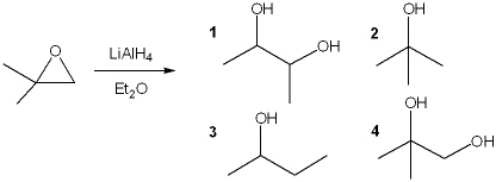
A) 1
B) 2
C) 3
D) 4

A) 1
B) 2
C) 3
D) 4

Unlock Deck
Unlock for access to all 71 flashcards in this deck.
Unlock Deck
k this deck
31
What is the best choice of reagent(s) to perform the following transformation? 
A) H2O
B) H2SO4, H2O
C) LiAlH4 followed by H3O+
D) KMnO4

A) H2O
B) H2SO4, H2O
C) LiAlH4 followed by H3O+
D) KMnO4

Unlock Deck
Unlock for access to all 71 flashcards in this deck.
Unlock Deck
k this deck
32
What is the major organic product obtained from the following reaction? 
A) 1
B) 2
C) 3
D) 4

A) 1
B) 2
C) 3
D) 4

Unlock Deck
Unlock for access to all 71 flashcards in this deck.
Unlock Deck
k this deck
33
What is the major organic product obtained from the following sequence of reactions? 
A) 1
B) 2
C) 3
D) 4

A) 1
B) 2
C) 3
D) 4

Unlock Deck
Unlock for access to all 71 flashcards in this deck.
Unlock Deck
k this deck
34
What is the major organic product obtained from the following sequence of reactions? 
A) 1
B) 2
C) 3
D) 4

A) 1
B) 2
C) 3
D) 4

Unlock Deck
Unlock for access to all 71 flashcards in this deck.
Unlock Deck
k this deck
35
What is the major organic product obtained from the following reaction? 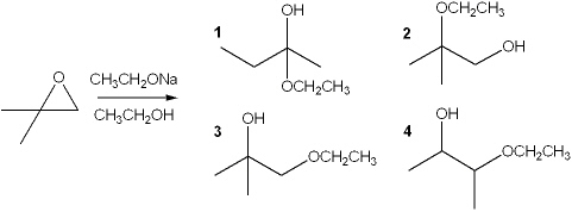
A) 1
B) 2
C) 3
D) 4

A) 1
B) 2
C) 3
D) 4

Unlock Deck
Unlock for access to all 71 flashcards in this deck.
Unlock Deck
k this deck
36
What is the best choice of reagent(s) to perform the following transformation? 
A) O3
B) peroxyacid
C) OsO4; followed by NaHSO3
D) H2O, H2SO4

A) O3
B) peroxyacid
C) OsO4; followed by NaHSO3
D) H2O, H2SO4

Unlock Deck
Unlock for access to all 71 flashcards in this deck.
Unlock Deck
k this deck
37
What type of reactive intermediate is formed in the reaction of methyl propene with methanol in the presence of an acid catalyst to give methyl tert-butyl ether (MTBE)?
A) tert-butyl cation
B) tert-butyl radical
C) tert-butyl anion
D) tert-butoxide
A) tert-butyl cation
B) tert-butyl radical
C) tert-butyl anion
D) tert-butoxide

Unlock Deck
Unlock for access to all 71 flashcards in this deck.
Unlock Deck
k this deck
38
What is the major organic product obtained from the following sequence of reactions? 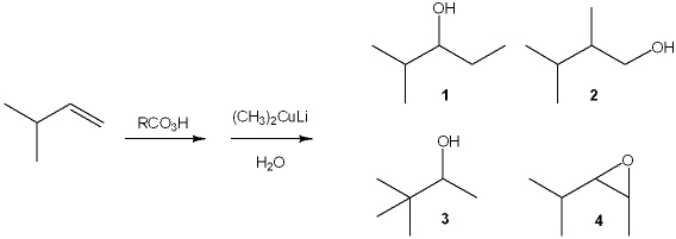
A) 1
B) 2
C) 3
D) 4

A) 1
B) 2
C) 3
D) 4

Unlock Deck
Unlock for access to all 71 flashcards in this deck.
Unlock Deck
k this deck
39
What is the major organic product obtained from the following reaction? 
A) only 1
B) only 2
C) only 3
D) both 2 and 3

A) only 1
B) only 2
C) only 3
D) both 2 and 3

Unlock Deck
Unlock for access to all 71 flashcards in this deck.
Unlock Deck
k this deck
40
What is the best choice of reagent(s) to perform the following transformation? 
A) peroxyacid
B) Br2, H2O; followed by NaOH, H2O
C) OsO4; followed by NaHSO3
D) H2O, H2SO4

A) peroxyacid
B) Br2, H2O; followed by NaOH, H2O
C) OsO4; followed by NaHSO3
D) H2O, H2SO4

Unlock Deck
Unlock for access to all 71 flashcards in this deck.
Unlock Deck
k this deck
41
What is the major organic product obtained from the following sequence of reactions? 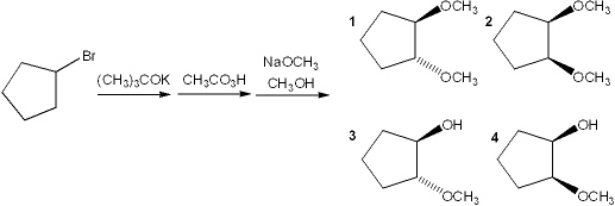
A) 1
B) 2
C) 3
D) 4

A) 1
B) 2
C) 3
D) 4

Unlock Deck
Unlock for access to all 71 flashcards in this deck.
Unlock Deck
k this deck
42
What is the name of the following compound? 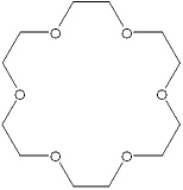
A) 6-crown-12
B) 12-crown-6
C) 18-crown-12
D) 18-crown-6

A) 6-crown-12
B) 12-crown-6
C) 18-crown-12
D) 18-crown-6

Unlock Deck
Unlock for access to all 71 flashcards in this deck.
Unlock Deck
k this deck
43
What would be the best choice of reagent(s) to perform the following transformation? 
A) CH3OH, H2SO4
B) NaOEt, followed by CH3OH
C) NaOEt, followed by CH3I
D) CH3OCH3

A) CH3OH, H2SO4
B) NaOEt, followed by CH3OH
C) NaOEt, followed by CH3I
D) CH3OCH3

Unlock Deck
Unlock for access to all 71 flashcards in this deck.
Unlock Deck
k this deck
44
Which of the following synthetic routes is used in industry to provide epichlorohydrin? 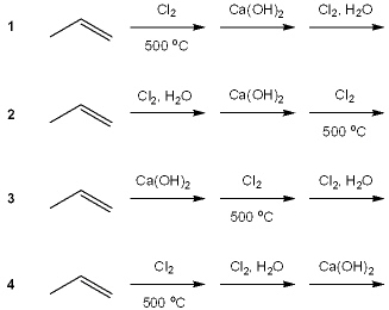
A) 1
B) 2
C) 3
D) 4

A) 1
B) 2
C) 3
D) 4

Unlock Deck
Unlock for access to all 71 flashcards in this deck.
Unlock Deck
k this deck
45
Which of the following ions forms the strongest complex with 18-crown-6?
A) Li+
B) Na+
C) K+
D) Rb+
A) Li+
B) Na+
C) K+
D) Rb+

Unlock Deck
Unlock for access to all 71 flashcards in this deck.
Unlock Deck
k this deck
46
What would be the best choice of reagent(s) to perform the following transformation? 
A) H3O+
B) H2O, NaOH
C) LiAlH4 followed by H3O+
D) H2O2

A) H3O+
B) H2O, NaOH
C) LiAlH4 followed by H3O+
D) H2O2

Unlock Deck
Unlock for access to all 71 flashcards in this deck.
Unlock Deck
k this deck
47
What is the major organic product obtained from the following reaction? 
A) 1
B) 2
C) 3
D) 4

A) 1
B) 2
C) 3
D) 4

Unlock Deck
Unlock for access to all 71 flashcards in this deck.
Unlock Deck
k this deck
48
What is the major organic product obtained from the following reaction? 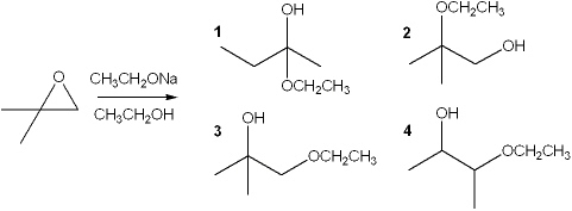
A) 1
B) 2
C) 3
D) 4

A) 1
B) 2
C) 3
D) 4

Unlock Deck
Unlock for access to all 71 flashcards in this deck.
Unlock Deck
k this deck
49
What is the major organic product obtained from the following reaction? 
A) 1
B) 2
C) 3
D) 4

A) 1
B) 2
C) 3
D) 4

Unlock Deck
Unlock for access to all 71 flashcards in this deck.
Unlock Deck
k this deck
50
What would be the best choice of reagent(s) to perform the following transformation? 
A) CH3S-Na+
B) CH3SH, H2SO4
C) CH3OH, Na2S
D) CH3I, H2SO4

A) CH3S-Na+
B) CH3SH, H2SO4
C) CH3OH, Na2S
D) CH3I, H2SO4

Unlock Deck
Unlock for access to all 71 flashcards in this deck.
Unlock Deck
k this deck
51
What is the IUPAC name of the following compound?



Unlock Deck
Unlock for access to all 71 flashcards in this deck.
Unlock Deck
k this deck
52
What is the major organic product obtained from the following sequence of reactions? 
A) 1
B) 2
C) 3
D) 4

A) 1
B) 2
C) 3
D) 4

Unlock Deck
Unlock for access to all 71 flashcards in this deck.
Unlock Deck
k this deck
53
Which of the following general structures can be made by sequential reaction of epichlorohydrin with appropriate nucleophiles? 
A) 1
B) 2
C) 3
D) 4

A) 1
B) 2
C) 3
D) 4

Unlock Deck
Unlock for access to all 71 flashcards in this deck.
Unlock Deck
k this deck
54
What is the major organic product obtained from the following reaction? 
A) 1
B) 2
C) 3
D) 4

A) 1
B) 2
C) 3
D) 4

Unlock Deck
Unlock for access to all 71 flashcards in this deck.
Unlock Deck
k this deck
55
What is the major organic product obtained from the following reaction? 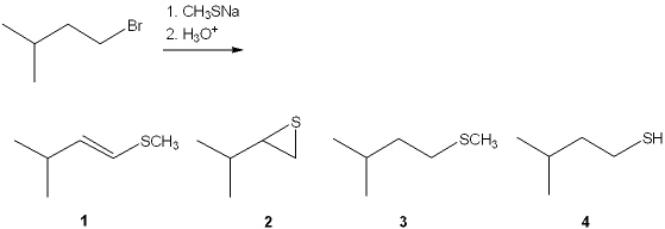
A) 1
B) 2
C) 3
D) 4

A) 1
B) 2
C) 3
D) 4

Unlock Deck
Unlock for access to all 71 flashcards in this deck.
Unlock Deck
k this deck
56
Which of the following statements is not true?
A) Crown ethers complex alkali metal ions by donation of lone pairs from the oxygen atoms to the metal cation.
B) Metal ion complexes of crown ethers dissolve in nonpolar aprotic organic solvents
C) Addition of 18-crown-6 to a solution of benzyl bromide and potassium cyanide in a nonpolar solvent increases the rate of nucleophilic substitution.
D) 18-Crown-6 is a planar molecule
A) Crown ethers complex alkali metal ions by donation of lone pairs from the oxygen atoms to the metal cation.
B) Metal ion complexes of crown ethers dissolve in nonpolar aprotic organic solvents
C) Addition of 18-crown-6 to a solution of benzyl bromide and potassium cyanide in a nonpolar solvent increases the rate of nucleophilic substitution.
D) 18-Crown-6 is a planar molecule

Unlock Deck
Unlock for access to all 71 flashcards in this deck.
Unlock Deck
k this deck
57
What is the major organic product obtained from the following sequence of reactions? 
A) 1
B) 2
C) 3
D) 4

A) 1
B) 2
C) 3
D) 4

Unlock Deck
Unlock for access to all 71 flashcards in this deck.
Unlock Deck
k this deck
58
What would be the best choice of reagent(s) to perform the following transformation? 
A) H2O2
B) NaIO4
C) H2O, NaOH
D) H2SO4

A) H2O2
B) NaIO4
C) H2O, NaOH
D) H2SO4

Unlock Deck
Unlock for access to all 71 flashcards in this deck.
Unlock Deck
k this deck
59
What is the major organic product obtained from the following reaction? 
A) 1
B) 2
C) 3
D) 4

A) 1
B) 2
C) 3
D) 4

Unlock Deck
Unlock for access to all 71 flashcards in this deck.
Unlock Deck
k this deck
60
What is the IUPAC name of the following compound?



Unlock Deck
Unlock for access to all 71 flashcards in this deck.
Unlock Deck
k this deck
61
What is the IUPAC name of the following compound?



Unlock Deck
Unlock for access to all 71 flashcards in this deck.
Unlock Deck
k this deck
62
What is the IUPAC name of the following compound?



Unlock Deck
Unlock for access to all 71 flashcards in this deck.
Unlock Deck
k this deck
63
What is the major organic product obtained from the following reaction?



Unlock Deck
Unlock for access to all 71 flashcards in this deck.
Unlock Deck
k this deck
64
What is the major organic product obtained from the following reaction?



Unlock Deck
Unlock for access to all 71 flashcards in this deck.
Unlock Deck
k this deck
65
What is the major organic product obtained from the following reaction?



Unlock Deck
Unlock for access to all 71 flashcards in this deck.
Unlock Deck
k this deck
66
What is the major organic product obtained from the following reaction?



Unlock Deck
Unlock for access to all 71 flashcards in this deck.
Unlock Deck
k this deck
67
Provide the structures of the sodium alkoxide and the alkyl iodide that would be the best starting materials for the preparation of the following compound by a Williamson ether synthesis.
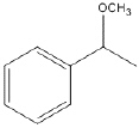


Unlock Deck
Unlock for access to all 71 flashcards in this deck.
Unlock Deck
k this deck
68
What is the major organic product obtained from the following reaction?
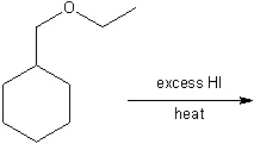


Unlock Deck
Unlock for access to all 71 flashcards in this deck.
Unlock Deck
k this deck
69
Provide the structures of the sodium alkoxide and the alkyl iodide that would be the best starting materials for the preparation of the following compound by a Williamson ether synthesis.



Unlock Deck
Unlock for access to all 71 flashcards in this deck.
Unlock Deck
k this deck
70
What is the major organic product obtained from the following reaction?



Unlock Deck
Unlock for access to all 71 flashcards in this deck.
Unlock Deck
k this deck
71
What is the major organic product obtained from the following reaction?



Unlock Deck
Unlock for access to all 71 flashcards in this deck.
Unlock Deck
k this deck



